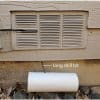Moving into a new home is an exciting adventure, but it also comes with its fair share of responsibilities, one of which is bug-proofing. Nobody wants to share their living space with unwanted creepy crawlies.
Fortunately, there are ways to bug-proof your new home, and experts have plenty of tips to share. In this article, we’ll explore six expert-backed tips for keeping bugs at bay in your new abode.
Seal the Cracks and Crevices
One of the most effective ways to prevent bugs from invading your new home is to seal up any cracks and crevices. Insects, such as ants, cockroaches, and even spiders, can find their way into your home through the tiniest openings.
Start by inspecting the exterior of your house for any gaps in the foundation, windows, doors, and utility entry points. Even the smallest crack can serve as an entryway for pests. To seal these openings, experts recommend using a high-quality silicone caulk or weatherstripping.
Make sure to pay special attention to areas around pipes, vents, and electrical outlets, as they are common entry points for bugs. By sealing up these potential access points, you create a barrier that can significantly reduce the likelihood of a bug invasion.
Keep a Clean and Clutter-Free Home
A clean and clutter-free home is not only visually appealing but also less inviting to bugs. Pests are attracted to food sources, moisture, and hiding spots. By eliminating these attractions, you make your home less appealing to insects. Here are some expert-recommended cleaning tips:
- Store food in airtight containers: Keep your pantry and kitchen cabinets organized with sealed containers to prevent ants, beetles, and other pantry pests from getting to your food.
- Regularly empty and clean trash cans: Garbage cans can be a breeding ground for flies and other insects. Make sure to empty and clean them regularly to reduce the attraction of pests.
- Fix plumbing leaks: Moisture attracts bugs like cockroaches and silverfish. Promptly repair any plumbing leaks to keep your home dry.
- Declutter regularly: Clutter provides hiding spots for pests. Regularly declutter and keep your home tidy to minimize pest hiding places.
Consider Professional Pest Control
Sometimes, despite your best efforts, pests can still find their way into your home. In such cases, it’s wise to consider professional pest control services. Pest control experts have the knowledge and tools to identify and eliminate infestations effectively and safely.
Consider experts like Reliable Pest Control Terminix, a well-established pest control company with a proven track record, that has the knowledge and tools to identify and eliminate infestations effectively and safely.
Regular pest control treatments can also be a proactive measure to prevent infestations from occurring in the first place. Many pest control companies offer routine inspections and treatments to keep your home bug-free.
Invest in Proper Outdoor Lighting
Outdoor lighting can significantly affect the presence of bugs around your home. Experts suggest using yellow or sodium vapor lights instead of traditional white lights. White lights tend to attract flying insects like moths, mosquitoes, and flies.
By switching to yellow or sodium vapor lights, you can reduce the number of bugs congregating around your home. Additionally, it’s essential to position lights away from doors and windows, directing the light away from entry points.
This helps prevent bugs from being drawn towards your home’s interior. Motion-activated lights can also be a useful tool in discouraging pests, as they only illuminate when someone is nearby.
Regularly Maintain Your Yard
Your yard’s condition can greatly impact the bug population around your home. To keep bugs at bay, experts recommend the following yard maintenance tips:
- Trim bushes and trees: Overgrown vegetation provides ideal hiding spots for pests. Regularly trim bushes and trees near your home to reduce hiding places for bugs.
- Remove standing water: Mosquitoes breed in standing water, so make sure to empty containers that collect water in your yard. This includes flower pots, bird baths, and clogged gutters.
- Use insect-repelling plants: Planting insect-repelling herbs and flowers like lavender, marigolds, and citronella can help deter bugs from your yard.
- Keep the lawn mowed: Short grass is less inviting to ticks and fleas, so keep your lawn well-maintained.
Educate Yourself About Local Pests
Different regions have different pest challenges. To effectively bug-proof your new home, it’s essential to educate yourself about the specific pests that are common in your area.
Local pest control experts can be a valuable resource for information on regional pests and effective prevention strategies. By understanding the behavior and habits of local pests, you can take targeted measures to keep them out of your home.
Whether it’s dealing with termites in the South, rodents in urban areas, or bedbugs in densely populated regions, local knowledge is a powerful tool in the fight against pests.
That’s A Wrap
Bug-proofing your new home is a crucial step in ensuring a comfortable and pest-free living environment. By following these six expert-backed tips, you can significantly reduce the likelihood of bugs invading your home.
These strategies will help you keep bugs at bay. And if pests do become a problem, don’t hesitate to seek professional pest control services. With the right knowledge and preventive measures, you can enjoy your new home without the unwelcome presence of bugs.








